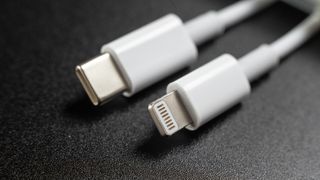Apple could be forced to give iPhones USB-C ports if new law passes
EU's new charger rules could cause more problems for Apple than just iPhones

Apple's Lightning connector is still tipped for the iPhone 14, but future iPhones and other products using proprietary chargers may have to give them up if the European Union gets its way.
In the name of reducing e-waste and complexity for customers, the EU has been aiming to make USB-C the standard charger for portable devices for several years. In the latest step forward for the "EU Common charger" legislation, the draft law has been amended to make it apply to larger devices like laptops, tablets and cameras as well as phones like the original plan suggested.
If you've heard about this story before, then it's because passing legislation can take an awfully long time. The first draft of the proposed legislation (after an extended consultation) passed in January this year, after several years of talks. The Internal Market and Consumer Protection Committee introduced the changes mentioned above, which will then go to another vote in the European Parliament in May before discussions begin on implementing the laws at a national level for EU members.
In addition, the MEPs want products to have information on charging options and whether there's a power brick included printed on the packaging. It's also requested the European Commission (the executive branch of the EU government) to propose a similar standard for wireless charging by 2026, which could impact things like Apple's MagSafe charging.
While this would affect all electronics companies operating in Europe, eyes tend to fall on Apple during these discussions, as it uses unique charging systems like the Lightning port. As you may have expected, Apple isn't keen on the EU's plans. It argues that the plan will hurt the economy and innovation, and no doubt the huge ecosystem of Lightning accessories also factors into Apple's opposition too.
Fortunately, outside of iPhones and the basic iPad, Apple already offers USB-C charging on the majority of the products that would be impacted if the EU enacted the rules as they stand. The only notable exceptions are the 14-inch MacBook Pro and 16-inch MacBook Pro, which can be charged via their USB-C Thunderbolt 4 ports but only offers their fastest available speeds via the proprietary MagSafe charging connector. This would allow Apple to meet the requirement while still offering its own proprietary standard, although this dual-port strategy wouldn't work on a much smaller tablet or phone.
Apple's AirPods wireless earbuds also use the Lightning port to charge. However, the current position of the EU is that smaller items like smartwatches will not be covered by the new rules, potentially giving Apple some extra wiggle room to keep Lightning going on some products.
Sign up to get the BEST of Tom’s Guide direct to your inbox.
Upgrade your life with a daily dose of the biggest tech news, lifestyle hacks and our curated analysis. Be the first to know about cutting-edge gadgets and the hottest deals.
We are probably still several years off from seeing USB-C become the EU's legally enforced charging standard. In the meantime, we have the iPhone 14 to look forward to. Despite early rumors saying the iPhone 14 Pro models would adopt USB-C, the latest we've heard is that Apple will only implement a new version of the Lightning port with faster data speeds on the Pros.

Richard is based in London, covering news, reviews and how-tos for phones, tablets, gaming, and whatever else people need advice on. Following on from his MA in Magazine Journalism at the University of Sheffield, he's also written for WIRED U.K., The Register and Creative Bloq. When not at work, he's likely thinking about how to brew the perfect cup of specialty coffee.
-
billykent1972 I'm all for standardization and I'm an Android user, however, I feel lightning is superior to USBC, with USBC, devices have a tiny board it "wraps" around, that is a weak spot. Lightning doesn't have that issue. Just my two cents.Reply
